2015.5 Peugeot 308 fold seats
[x] Cancel search: fold seatsPage 62 of 396
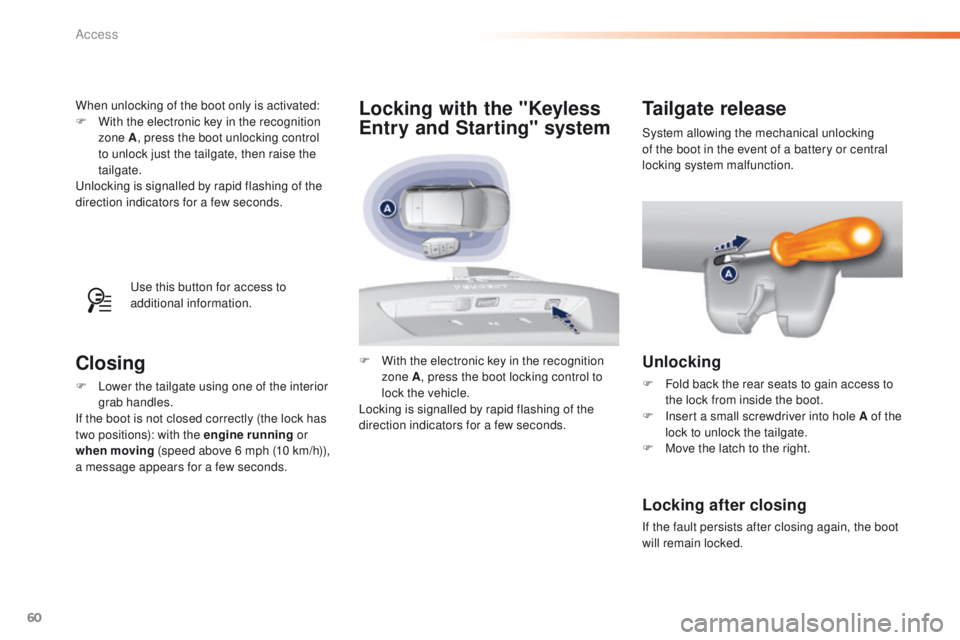
60
When unlocking of the boot only is activated:
F W ith the electronic key in the recognition
zone A , press the boot unlocking control
to unlock just the tailgate, then raise the
tailgate.
un
locking is signalled by rapid flashing of the
direction indicators for a few seconds.
us
e this button for access to
additional information.
Closing
F Lower the tailgate using one of the interior grab handles.
If the boot is not closed correctly (the lock has
two positions): with the engine running or
when moving (speed above 6 mph (10 km/h)),
a message appears for a few seconds.
Tailgate release
Unlocking
F Fold back the rear seats to gain access to the lock from inside the boot.
F
I
nsert a small screwdriver into hole A of the
lock to unlock the tailgate.
F
M
ove the latch to the right.
Locking after closing
If the fault persists after closing again, the boot
will remain locked.System allowing the mechanical unlocking
of the boot in the event of a battery or central
locking system malfunction.
F
W
ith the electronic key in the recognition
zone A , press the boot locking control to
lock the vehicle.
Locking is signalled by rapid flashing of the
direction indicators for a few seconds.
Locking with the "Keyless
Entry and Starting" system
Access
Page 79 of 396
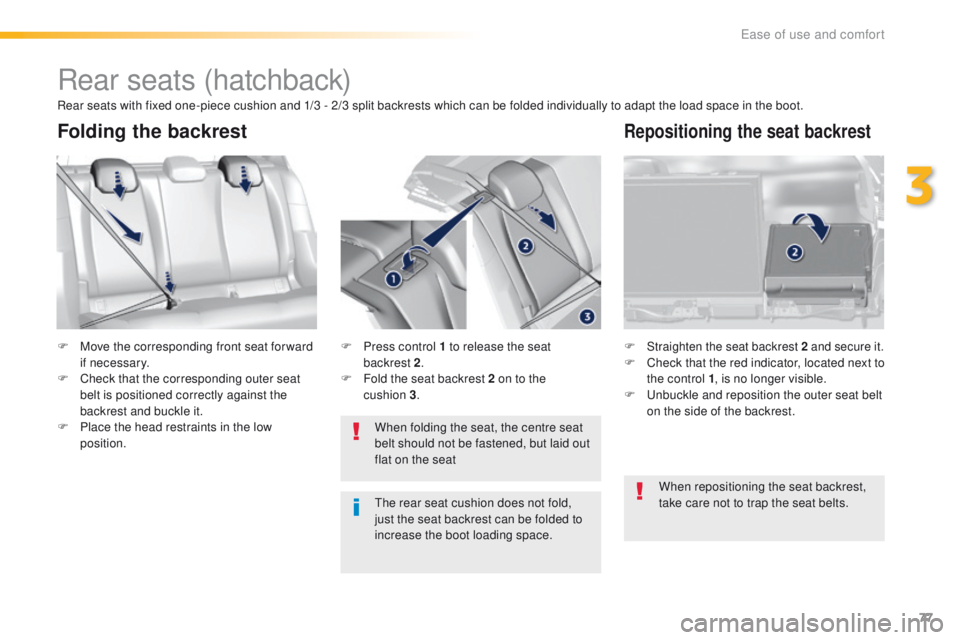
77
Rear seats (hatchback)
F Move the corresponding front seat for ward if necessary.
F
C
heck that the corresponding outer seat
belt is positioned correctly against the
backrest and buckle it.
F
P
lace the head restraints in the low
position. F
Straighten the seat backrest 2 and secure it.F Check that the red indicator, located next to
the control 1 , is no longer visible.
F
u
n
buckle and reposition the outer seat belt
on the side of the backrest.
When folding the seat, the centre seat
belt should not be fastened, but laid out
flat on the seat
F
P
ress control 1 to release the seat
backrest
2
.
F
F
old the seat backrest 2 on to the
cushion
3 .
Folding the backrestRepositioning the seat backrest
Rear seats with fixed one-piece cushion and 1/3 - 2/3 split backrests which can be folded individually to adapt the load space in the boot.
th
e rear seat cushion does not fold,
just the seat backrest can be folded to
increase the boot loading space. When repositioning the seat backrest,
take care not to trap the seat belts.
3
ease of use and comfort
Page 80 of 396
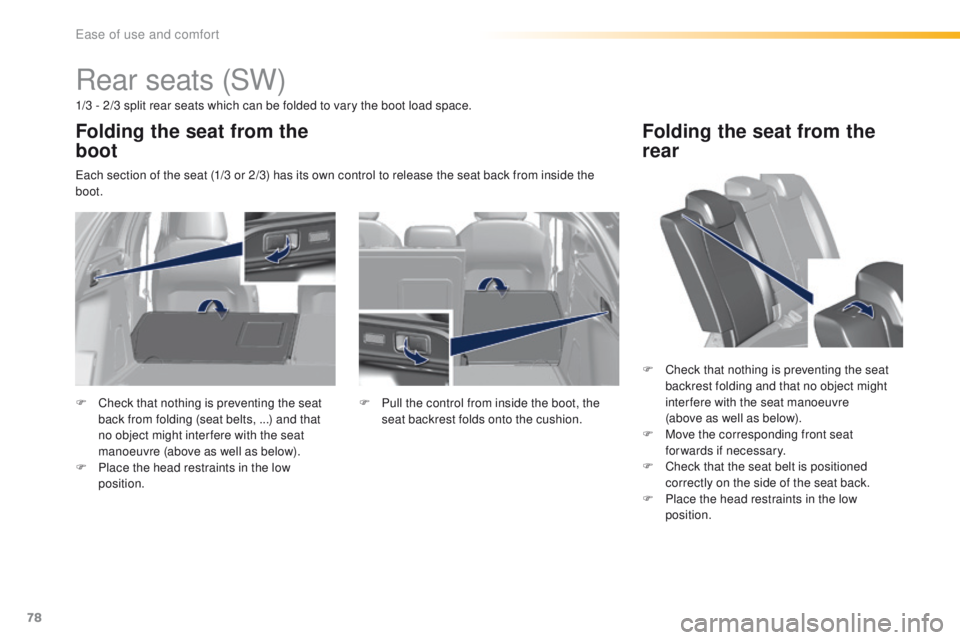
78
Rear seats (SW)
1/3 - 2/3 split rear seats which can be folded to vary the boot load space.
ea
ch section of the seat (1/3 or 2/3) has its own control to release the seat back from inside the
boot.
Folding the seat from the
boot
F Check that nothing is preventing the seat back from folding (seat belts, ...) and that
no object might inter fere with the seat
manoeuvre (above as well as below).
F
P
lace the head restraints in the low
position. F
P ull the control from inside the boot, the
seat backrest folds onto the cushion.
Folding the seat from the
rear
F Check that nothing is preventing the seat backrest folding and that no object might
interfere with the seat manoeuvre
(above as well as below).
F
M
ove the corresponding front seat
forwards if necessary.
F
C
heck that the seat belt is positioned
correctly on the side of the seat back.
F
P
lace the head restraints in the low
position.
ease of use and comfort
Page 91 of 396
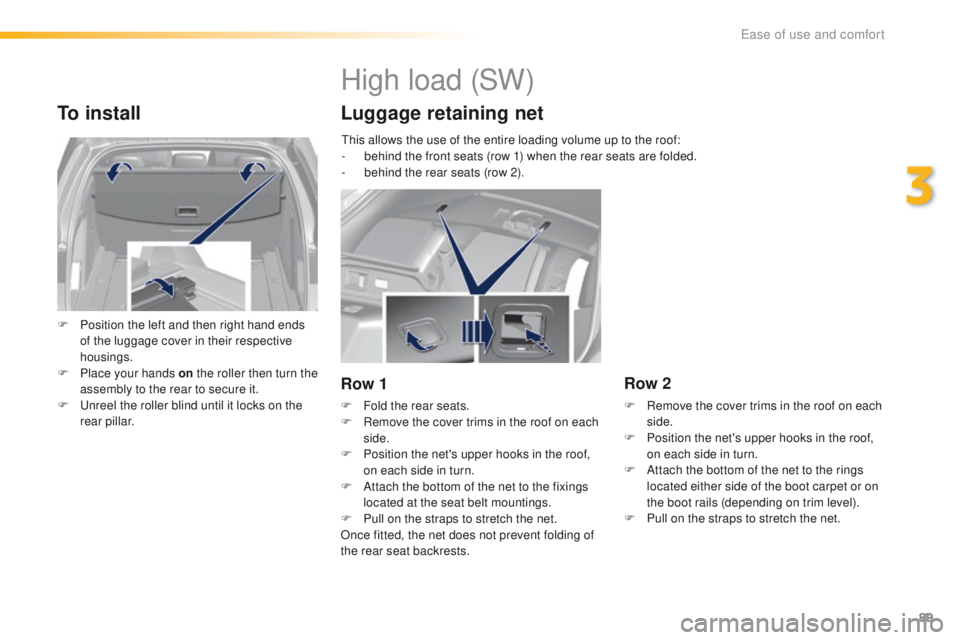
89
To install
F Position the left and then right hand ends of the luggage cover in their respective
housings.
F
P
lace your hands on the roller then turn the
assembly to the rear to secure it.
F
u
n
reel the roller blind until it locks on the
rear pillar.
High load (SW)
Luggage retaining net
Row 1
F Fold the rear seats.
F R emove the cover trims in the roof on each
side.
F
P
osition the net's upper hooks in the roof,
on each side in turn.
F
A
ttach the bottom of the net to the fixings
located at the seat belt mountings.
F
P
ull on the straps to stretch the net.
Once fitted, the net does not prevent folding of
the rear seat backrests.
Row 2
F Remove the cover trims in the roof on each side.
F
P
osition the net's upper hooks in the roof,
on each side in turn.
F
A
ttach the bottom of the net to the rings
located either side of the boot carpet or on
the boot rails (depending on trim level).
F
P
ull on the straps to stretch the net.
th
is allows the use of the entire loading volume up to the roof:
-
b
ehind the front seats (row 1) when the rear seats are folded.
-
b
ehind the rear seats (row 2).
3
Ease of use and comfort
Page 127 of 396
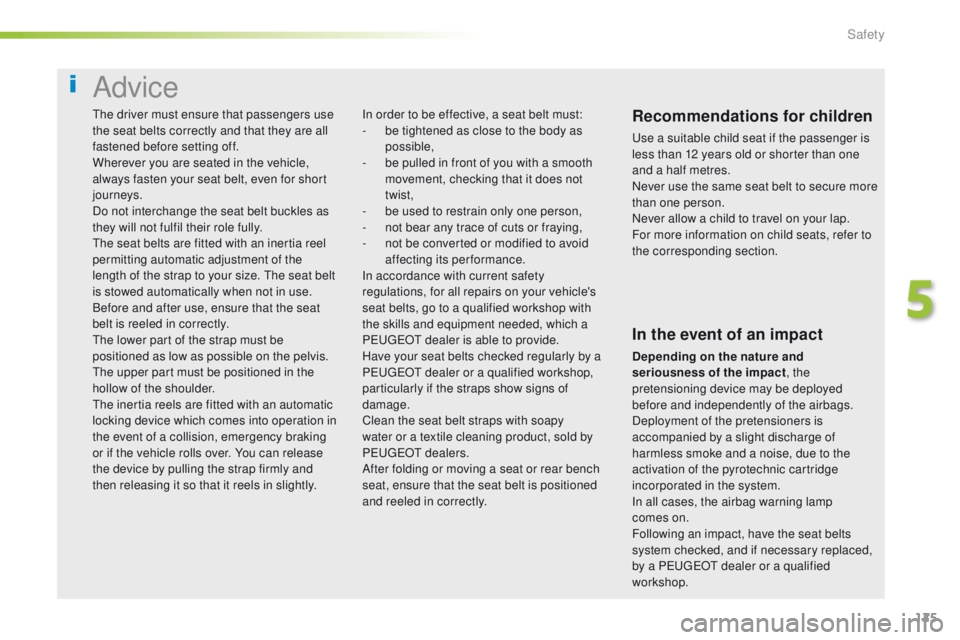
125
Advice
Recommendations for children
use a suitable child seat if the passenger is
less than 12 years old or shorter than one
and a half metres.
Never use the same seat belt to secure more
than one person.
Never allow a child to travel on your lap.
For more information on child seats, refer to
the corresponding section.
In order to be effective, a seat belt must:
-
b
e tightened as close to the body as
possible,
-
b
e pulled in front of you with a smooth
movement, checking that it does not
twist,
-
b
e used to restrain only one person,
-
n
ot bear any trace of cuts or fraying,
-
n
ot be converted or modified to avoid
affecting its performance.
In accordance with current safety
regulations, for all repairs on your vehicle's
seat belts, go to a qualified workshop with
the skills and equipment needed, which a
P
e
uge
Ot d
ealer is able to provide.
Have your seat belts checked regularly by a
P
e
uge
Ot
dealer or a qualified workshop,
particularly if the straps show signs of
damage.
Clean the seat belt straps with soapy
water or a textile cleaning product, sold by
P
e
uge
Ot d
ealers.
After folding or moving a seat or rear bench
seat, ensure that the seat belt is positioned
and reeled in correctly.
In the event of an impact
Depending on the nature and
seriousness of the impact , the
pretensioning device may be deployed
before and independently of the airbags.
Deployment of the pretensioners is
accompanied by a slight discharge of
harmless smoke and a noise, due to the
activation of the pyrotechnic cartridge
incorporated in the system.
In all cases, the airbag warning lamp
comes
on.
Following an impact, have the seat belts
system checked, and if necessary replaced,
by a P
e
uge
Ot
dealer or a qualified
workshop.
the
driver must ensure that passengers use
the seat belts correctly and that they are all
fastened before setting off.
Wherever you are seated in the vehicle,
always fasten your seat belt, even for short
journeys.
Do not interchange the seat belt buckles as
they will not fulfil their role fully.
th
e seat belts are fitted with an inertia reel
permitting automatic adjustment of the
length of the strap to your size.
t
h
e seat belt
is stowed automatically when not in use.
Before and after use, ensure that the seat
belt is reeled in correctly.
th
e lower part of the strap must be
positioned as low as possible on the pelvis.th
e upper part must be positioned in the
hollow of the shoulder.
th
e inertia reels are fitted with an automatic
locking device which comes into operation in
the event of a collision, emergency braking
or if the vehicle rolls over. You can release
the device by pulling the strap firmly and
then releasing it so that it reels in slightly.
5
Safety
Page 386 of 396
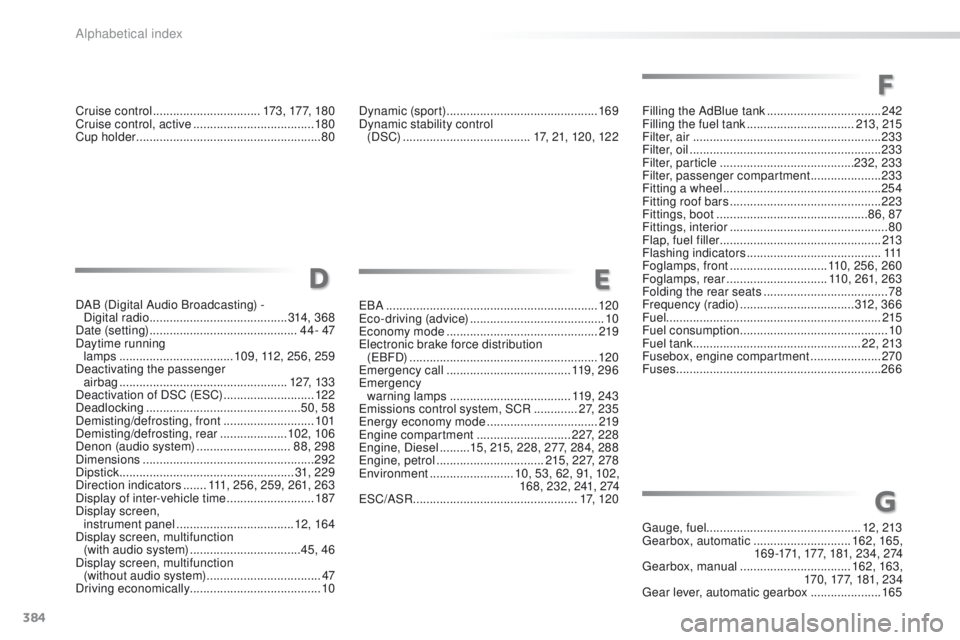
384
eBA ............................................................... 120ec
o-driving (advice) ........................................ 10
ec
onomy mode
............................................. 219
el
ectronic brake force distribution
(
eB
FD)
........................................................ 120
em
ergency call
..................................... 11
9 , 2 9 6
em
ergency
warning lamps
.................................... 11 9 , 2 4 3
em
issions control system, SCR .............2 7, 2 3 5
en
ergy economy mode
.................................219
en
gine compartment
............................227, 228
en
gine, Diesel
......... 1
5, 215, 228, 277, 284, 288
en
gine, petrol
................................ 215, 227, 278
en
vironment
......................... 1
0, 53, 62, 91, 102,
168, 232, 241, 274
eS
C/ASR
...............................
..................17, 1 2 0
E
G
Dynamic (sport) ............................... ..............169
Dynamic stability control (DSC)
...................................... 17, 21, 120, 12 2
Cruise control ................................
17
3 , 17 7, 18 0
Cruise control, active
.................................... 180
Cup holder
...............................
........................ 80
ga
uge, fuel.............................................. 12, 213
ge
arbox, automatic
.............................162, 165,
169 -171, 177, 181, 234, 274
ge
arbox, manual
.................................162, 163,
170, 177, 181, 234
gea
r lever, automatic gearbox
.....................16
5
Filling the AdBlue tank
..................................242
Filling the fuel tank
................................21
3, 215
Filter, air
...............
.........................................233
Filter, oil
.........................................................233
Filter, particle
........................................232, 233
Filter, passenger compartment
.....................233
Fitting a wheel
...............................
................254
Fitting roof bars
.............................................223
Fittings, boot
............................................. 8
6, 87
Fittings, interior
...............................................80
Flap, fuel filler
...............................
.................213
Flashing indicators
........................................111
Foglamps, front
.............................110, 256, 260
Foglamps, rear
..............................110, 261, 263
Folding the rear seats
.....................................78
Frequency (radio)
..................................312, 3 6 6
Fuel ................................................................ 215
Fuel consumption
............................................ 10
Fu
el tank.................................................. 2 2, 213
Fusebox, engine compartment
.....................270
Fuses
.............................................................266
DAB (Digital Audio Broadcasting) -
Digital radio
......................................... 314, 3 6 8
Date (setting)
...............................
............. 4 4 - 47
Daytime running lamps
..............................
.... 109, 112, 256, 259
Deactivating the passenger airbag
.................................................. 1
2 7, 1 3 3
Deactivation of DSC (
e
SC)
........................... 12 2
Deadlocking
.............................................. 50, 58
Demisting/defrosting, front
........................... 101
Demisting/defrosting, rear
.................... 10
2, 10 6
Denon (audio system)
............................ 88, 298
Dimensions
................................................... 292
Dipstick
................
.................................... 31, 2 29
Direction indicators
....... 111, 256, 259, 261, 263
Display of inter-vehicle time
.......................... 187
Display screen, instrument panel
...............................
.... 12, 16 4
Display screen, multifunction (with audio system)
................................. 45, 46
Display screen, multifunction (without audio system)
.................................. 47
Driving economically ....................................... 10
D
F
Alphabetical index